Tonsillectomy is an operation to remove glands. Can be administered under local or general anesthesia, but has a number of contraindications and is dangerous for the likelihood of complications.
Contents
- Laser and radio wave tonsillectomy: indications
- Video: Removal of palatine tonsils. We treat correctly with Vladimir Zaitsev
- Tonsillectomy bilateral: course of operation
- Tonsillectomy and postoperative period
- Bleeding after tonsillectomy
- Complications after tonsillectomy
- How many sore throats after tonsillectomy?
- How much is the temperature after tonsillectomy?
- Consequences of tonsillectomy
- Eating after tonsillectomy: diet
- Recovery after tonsillectomy - rehabilitation
- Is it possible to have tonsillitis after tonsillectomy?
- Tonsillectomy under general anesthesia reviews
- Video: Tonsillectomy. Types of operation. We treat correctly with Vladimir Zaitsev
Despite the fact that tonsils carry a protective function for the whole organism, their hypertrophy can cause a lot of harm, ranging from angina and chronic tonsillitis, ending with heart, kidney and joint damage.
In cases where conservative treatment is powerless, an otorhinolaryngologist is recommended to perform tonsillectomy - complete removal of the glands.
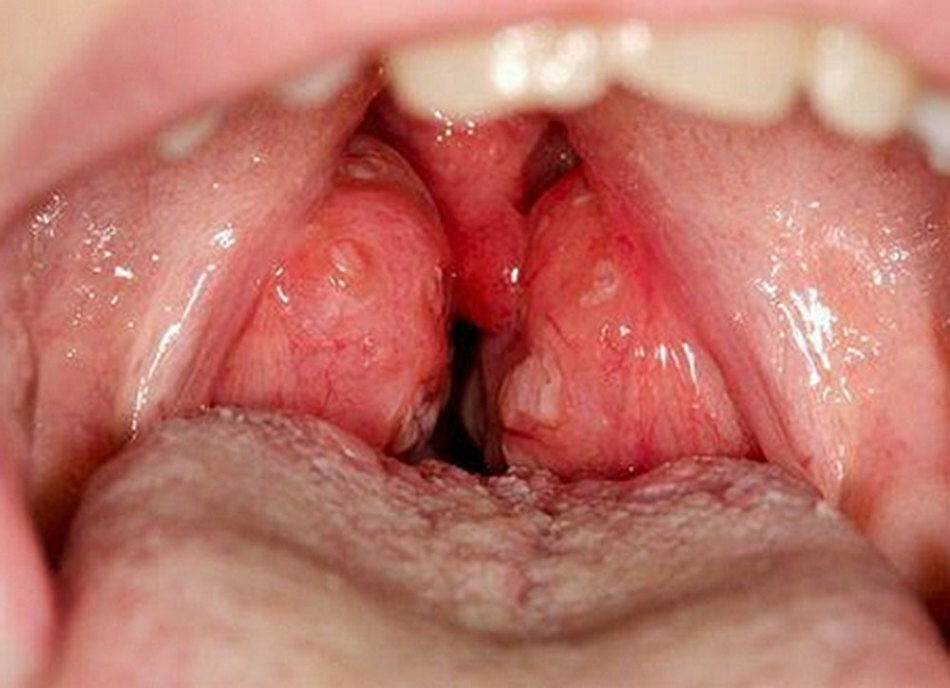 Hypertrophy of tonsils - indication for tonsillectomy
Hypertrophy of tonsils - indication for tonsillectomy Laser and radio wave tonsillectomy: indications
Radio wave tonsillectomy is an operation for the removal of tonsils with the help of a laser. It is modern, highly effective, bloodless and least traumatic of the known method.
It provides rapid postoperative healing without the formation of gross scars.
In spite of the fact that tonsillectomy is a simple operation, serious medical indications should be used for its carrying out. These include:
- frequent exacerbations of chronic tonsillitis
- angina
- severe peritonsillar abscess
- tonzillogennaya rhinitis
- sinusitis
- pharyngitis
- neck limfoadenity
- traheobronhity
- presence in tonsils infectious-allergic hearth
- renal disease tonzillogennaya character
- endocrine disorders caused by the influence of chronic tonsillitis
- someskin diseases( eczema, urticaria, psoriasis, streptoderma)
- obstructed swallow
- apnea
- snoring
- fade violation
- hearing impairment( decrease)
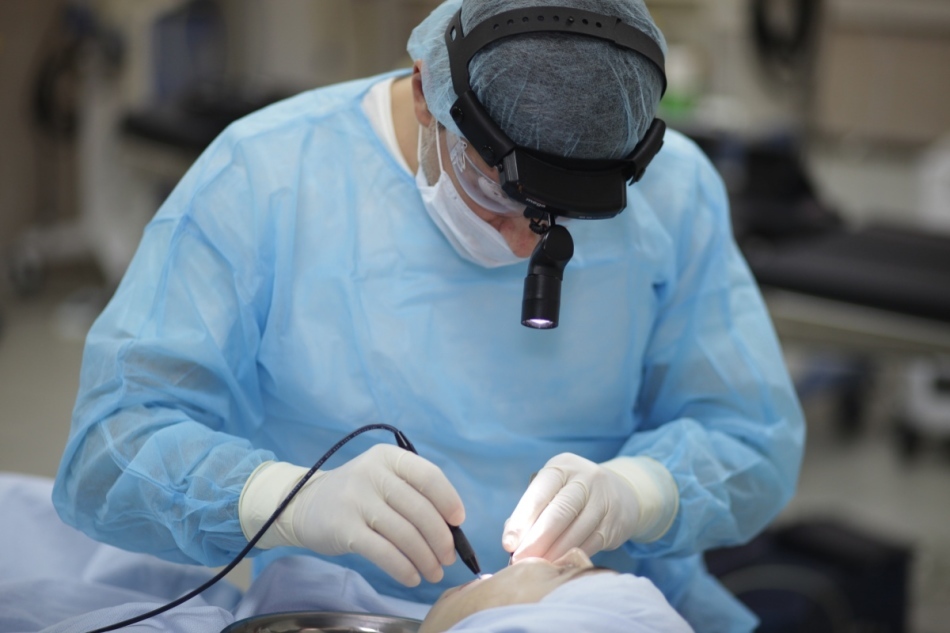 Radio wave tonsillectomy
Radio wave tonsillectomy However, there are contraindications to the for carrying out tonsillectomy, which also can not be forgotten.
Video: Removal of palatine tonsils. Treat correctly Vladimir Zaitsev
Absolute contraindications :
- anemia
- leukemia
- hemophilia
- agranulocytosis
- scurvy
relative contraindications:
- SARS and rehabilitation after disease( 1 - 1.5 months)
- anemia
- menstruation
- dental caries dermatitis in stepexacerbations of
- 1 and 3 trimesters of pregnancy
- acute tonsillitis( first 14 days of illness)
- vascular peritonosylar abnormalities
- age of patient younger than 2 - 2.5 years of
- epidemic of flupa and poliomyelitis
The otorhinolaryngologist, together with a therapist or pediatrician, takes the decision to perform the operation if the tonsillectomy is necessary for the child, after examining the patient and assessing his condition. Before the operation, the patient is obliged to undergo scheduled examinations and give tests.
 Severe snoring is one of the indications for tonsillectomy
Severe snoring is one of the indications for tonsillectomy IMPORTANT: Failure to comply with indications and contraindications to tonsillectomy can lead to further persistent throat diseases in the patient, as well as the development of a neurotic syndrome.
Tonsillectomy bilateral: the course of operation
Tonsillectomy can be performed under both local and general anesthesia .Adult patients who are able to safely transfer surgical manipulations to remove glands, recommended the first option. Children and impressionable adults undergo general anesthesia.
Anesthesia is administered under the mucous membrane of the anterior and posterior palatine arch. After the administration of an anesthetic, a 2-3 minute pause occurs. At this time, the doctor explains to the patient how to behave during the operation.
Then proceed to the operation itself: dissect the mucosa, grasp the tonsil with toothed forceps or a curved clamp and peel it off. To do this, short vertical, and then longer, envelopes are made in the section.
IMPORTANT: Reliable, firm grip of the tonsils must be carried out with the capsule. If the capsule exfoliates heavily, the strands formed by the scar tissue are scissors cut.
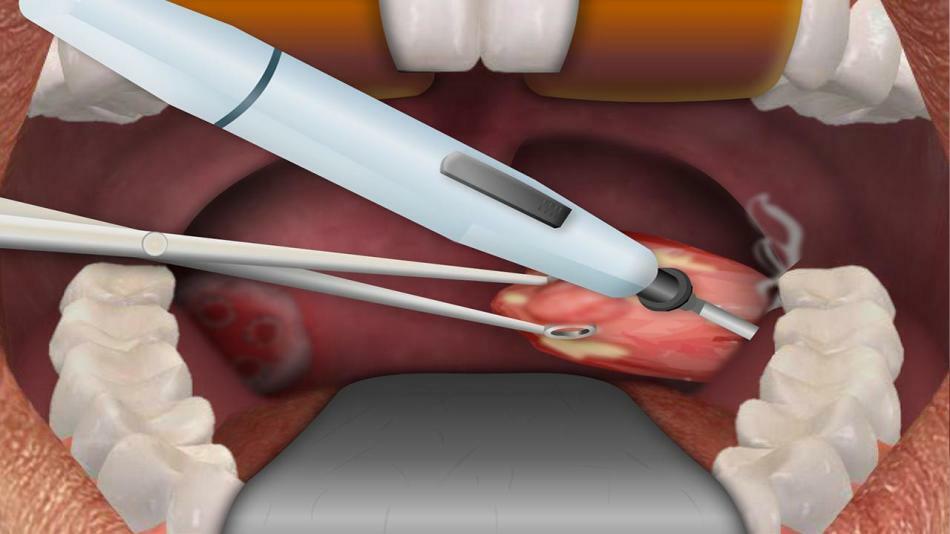 Tonsillectomy - removal of tonsils
Tonsillectomy - removal of tonsils If the operating field is filled with blood, the surgeon holds the zamindal area with a gauze pad and puts it into the second gland detachment. After partial clipping of the second gland, the doctor swabs it and returns to the first amygdala. This method allows you to perform manipulations in the visual control of the operated area.
IMPORTANT: The application of the loop is carried out at the moment when half of the amygdala is peeled off, but it does not yet hang down in the pharynx.
The excision of the amygdala is carried out when it remains on a thin web and is already hanging in the pharynx, with the help of a loop or, if the vessels are too small, without it.
IMPORTANT: During anesthesia and immediately before the actual clipping, additional anesthesia is sometimes administered.
Tonsillectomy and the postoperative period
The postoperative period provides for bed rest and medical supervision. Particular attention should be paid to the pharyngeal wound. It is unacceptable to drain a significant amount of blood from it into the stomach.
For analgesia, the patient is prescribed analgin or ibuprofen.
IMPORTANT: Since immediately after the operation, swallowing solid food is difficult and can provoke bleeding, it should be limited to small portions of fermented milk products and mashed bananas in puree.
A week after the operation, all the functions of the body are completely restored. Usually by this time( or even somewhat earlier) the patient is discharged from the hospital.
 Bed rest after tonsillectomy
Bed rest after tonsillectomy Bleeding after tonsillectomy
After removal of tonsils, may occur early and late bleeding . Early bleeding occurs if the operating surgeon has not stitched or stitched enough amygdala niches.
Late bleeding occurs after the primary healing of the surgical site( usually between 5 and 8 days), last an average of 3-5 minutes, and then independently stop. Usually these bleedings are formal and do not cause concern. However, any later bleeding after tonsillectomy requires immediate medical attention.
If blood gets into the stomach during bleeding, vomiting occurs, followed by vomiting with large amounts of blood.
IMPORTANT: The risk of significant early and late postoperative bleeding is the large loss of blood and the probability of asphyxia during sleep due to paralysis of the respiratory center.
signs of significant blood loss after tonsillectomy :
- unnatural pallor
- lingering apathetic state
- on the skin acts as a cold sweat
- reduced
- pressure weak thready pulse
- intermittent rapid breathing
- badly bugged heart
- strong thirst
- unconsciousness
- involuntary urination anddeformation
IMPORTANT: Despite the likelihood of an independent cessation of severe bleeding, the very appearance of it can lead to shock and, in the absence of proper urgent medical attention, to the patient's death.
The first aid for bleeding after tonsillectomy is in the intensive care unit by transfusion of blood and / or blood substitute fluid.
If the bleeding does not stop, the patient is given blood-thinning preparations and vitamins .
 Weakness, skin pallor and pressure drop-signs of bleeding after tonsillectomy
Weakness, skin pallor and pressure drop-signs of bleeding after tonsillectomy Complications after tonsillectomy
In addition to bleeding after tonsillectomy, other complications may occur, such as :
- postoperative angina, pharyngitis
- inflammation of pharynx and palate
- pharyngeal abscess due to infectionor trauma of the pharynx in the
- operation time
- diphtheria
- purulent otitis
- bronchopneumonia
- thrombosis of pharyngeal venous plexus
- acetonemia
- agranulocytosis
- hyperthermic syndrome
- hyperthermia syndrome
- diabetes insipidus transient diabetes
- acute laryngeal edema
- spouting of saliva due to injuries of the submaxillary gland
- appearance of gross scars
- complicated swallowing
- pain in the throat
IMPORTANT: The listed complications are rare and usually occur due to non-compliance with preparation for surgery orpostoperative treatment. Also, complications can provoke ARVI, influenza, pneumonia, bronchitis.
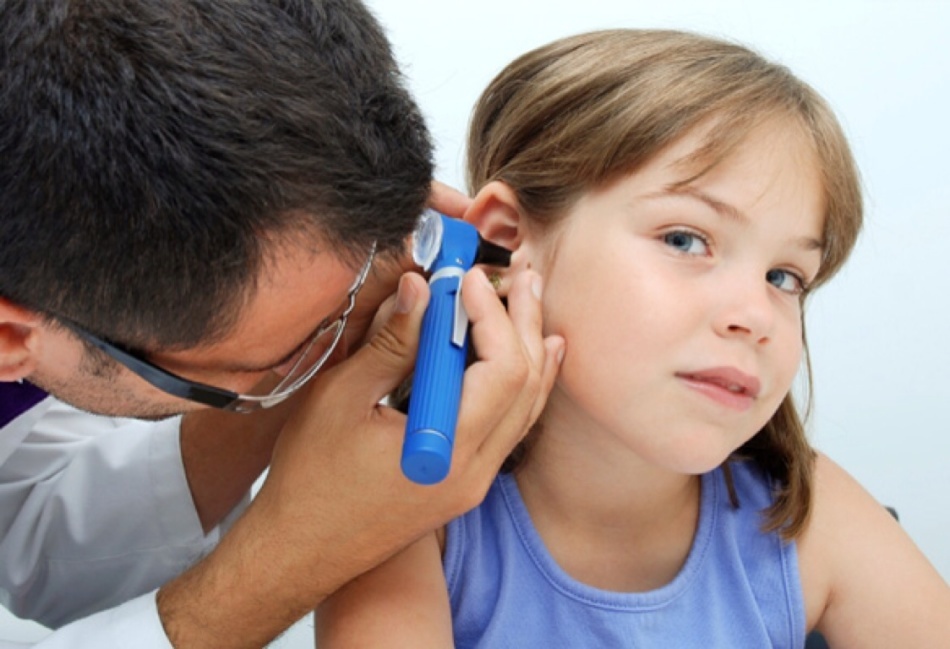 Purulent otitis is one of possible complications of tonsillectomy
Purulent otitis is one of possible complications of tonsillectomy . How much does the throat ache after tonsillectomy?
The duration and intensity of sore throat after tonsillectomy is affected by several factors:
- The method of performing the operation .After removal of the tonsils with a scalpel, loop or scissors, the pain can last 1 - 2 weeks .After cryodestruction and laser vaporization pain in the throat occurs during 1 - 3 days.
- Features of power supply after operation .If after the operation the patient does not follow the doctor's recommendations and consumes hot, sharp, salty and hard food, the throat will heal longer. At times, reducing the healing time of the wound and reducing the period of the onset of pain will help the consumption of semi-liquid, grinded, mild, warm foods.
 Sore throat after tonsillectomy
Sore throat after tonsillectomy How much is the temperature after tonsillectomy?
After the operation, the temperature of 37 - 37,8˚С rises in most patients and lasts about 3 - 10 days .
Doctors recommend taking ibuprofen( nurofen) to relieve pain and normalize body temperature. However, if the temperature of the is above 38 ° C or lasts more than 10 days, , it is necessary to consult a doctor to find out the reasons and additional examinations.
 Temperature after tonsillectomy
Temperature after tonsillectomy Consequences of tonsillectomy
In addition to the positive effect, improving health, stopping snoring and stopping breathing in sleep, facilitating breathing and swallowing, after tonsillectomy, the patient's state of health may also worsen.
IMPORTANT: It is not recommended to remove palatine tonsils from singers, speakers( teachers, lecturers), workers employed in harmful dusty production.
Some patients with removed palatine tonsils complain of dry mouth, sore throat and recurrent pharyngitis .However, the majority of those who have undergone tonsillectomy note that after the operation of the disease they have finally receded and the quality of life has improved noticeably.
In order to avoid negative consequences after the operation to remove tonsils, the doctor needs to take a very serious approach to the decision to conduct it. In cases where tonsilectomy can be replaced by partial removal of tonsils, it is better to conduct this procedure.
IMPORTANT: It has been proved that tonsileectomy does not affect the state of general immunity, and the benefit from surgery significantly exceeds the risk of possible complications.
 Continuous dry mouth - one of the negative consequences of tonsillectomy
Continuous dry mouth - one of the negative consequences of tonsillectomy Nutrition after tonsillectomy: diet
Before carrying out tonsillectomy, doctors are often advised to refrain from eating on the first day after the operation, explaining this by the likelihood of the appearance of pain and bleeding. The development of the throat and restoration of its functions begin with the intake of still water in small portions.
IMPORTANT: Usual food is forbidden at first because, in addition to irritating her throat, the body after anesthesia will not be able to digest incoming food and will try to get rid of it through vomiting.
If you refuse to eat too hard, you can eat chilled dairy products and ice cream in the first day after the operation.
Such snacks will only benefit, because the cold narrows the damaged blood vessels, reducing pain, and milk saturates the body.
A few days after the operation, it is allowed to eat unsalted chicken broth.
IMPORTANT: The first portions of food should be very small. You can increase them several times the next day.
In the first week after surgery, any consumed food should be cold and maximally ground .Return to their habitual diet for patients allowed after complete healing of wounds.
 In the first week after carrying out tonsillectomy, doctors recommend taking mainly cold acidic milk products
In the first week after carrying out tonsillectomy, doctors recommend taking mainly cold acidic milk products Recovery after tonsillectomy - rehabilitation
Recovery after tonsillectomy lasts for about 14 days .At this time, can be noted with complicated nasal breathing, sore throat, swelling of the nasopharynx.
To prevent the formation of scars, needs to use local hormone preparations within the first 2 weeks after the operation.
To ease nasal breathing vasoconstrictor drops will help, anesthetize - ibuprofen or analgin , and relieve swelling - an antihistamine.
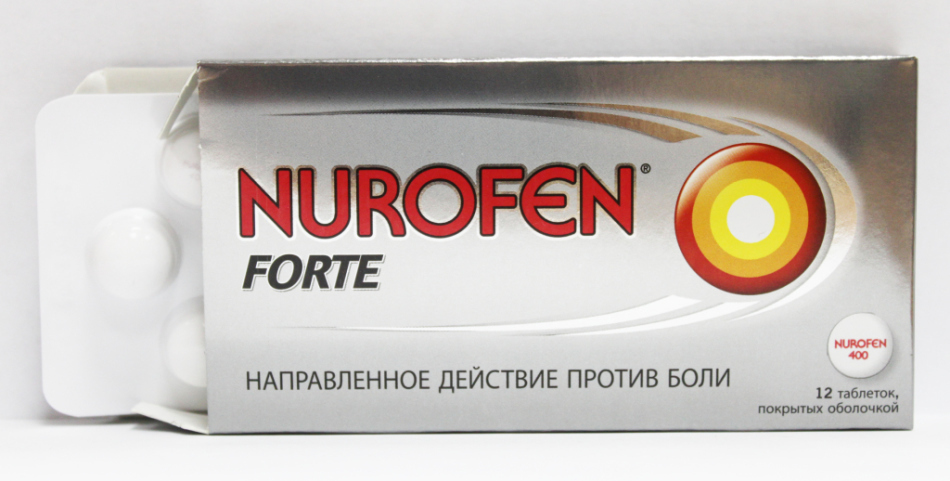 Nurofen - a drug against pain and temperature after tonsillectomy
Nurofen - a drug against pain and temperature after tonsillectomy Is angina possible after tonsillectomy?
Angina without glands is possible. However, it is not the palatine tonsils that fall under the shock, but the lymphatic formations of the okolobloth ring. The situation is somewhat facilitated by the absence of large foci of infection, but treatment of sore throat will also have to be done with antibacterial drugs under the supervision of a doctor.
Tonsillectomy under general anesthesia reviews
Tatiana, 32 years old: Adenoids and glands were removed to the son( 4,5 years old) under general anesthesia. The operation was successful, there were no serious complications. From the operating room son was brought to the room asleep. Gradually, he came to, but until the evening was sleepy and capricious. Several times I snatched away the blood, but the doctor said that this is normal, since during the operation a small part of the blood got into the stomach. When my son complained of a sore throat, I gave him nurofen syrup. A few days later we were allowed to go home. My boy quickly recovered and returned to normal life. We are very pleased that we took a chance and agreed to an operation that changed the life of my son. More than a year has passed since the removal of the tonsils, and since then he has never missed a kindergarten because of illness.
Olga, 42: After removing tonsils, my life turned into hell: there were constant headaches, sore throat, incomprehensible temperature jumps. I very much regret that I went for it.
Anton, 27 years old: Operation was not pleased. The doctor sloppily performed his work, cut out a small tongue. On a place of glands there were terrible scars. I hoped they would dissolve, but they only become denser.
Although tonsillectomy is a simple, common operation that should not be feared, it is still an extreme measure. Before you cut the tonsils, it's worth trying to fight for your health. To do this, it is necessary to treat throat diseases on time, using not only sprays and tablets, but also rinses with decoctions of medicinal herbs, treatment of inflamed tonsils with antiseptic solutions and physiotherapy.
